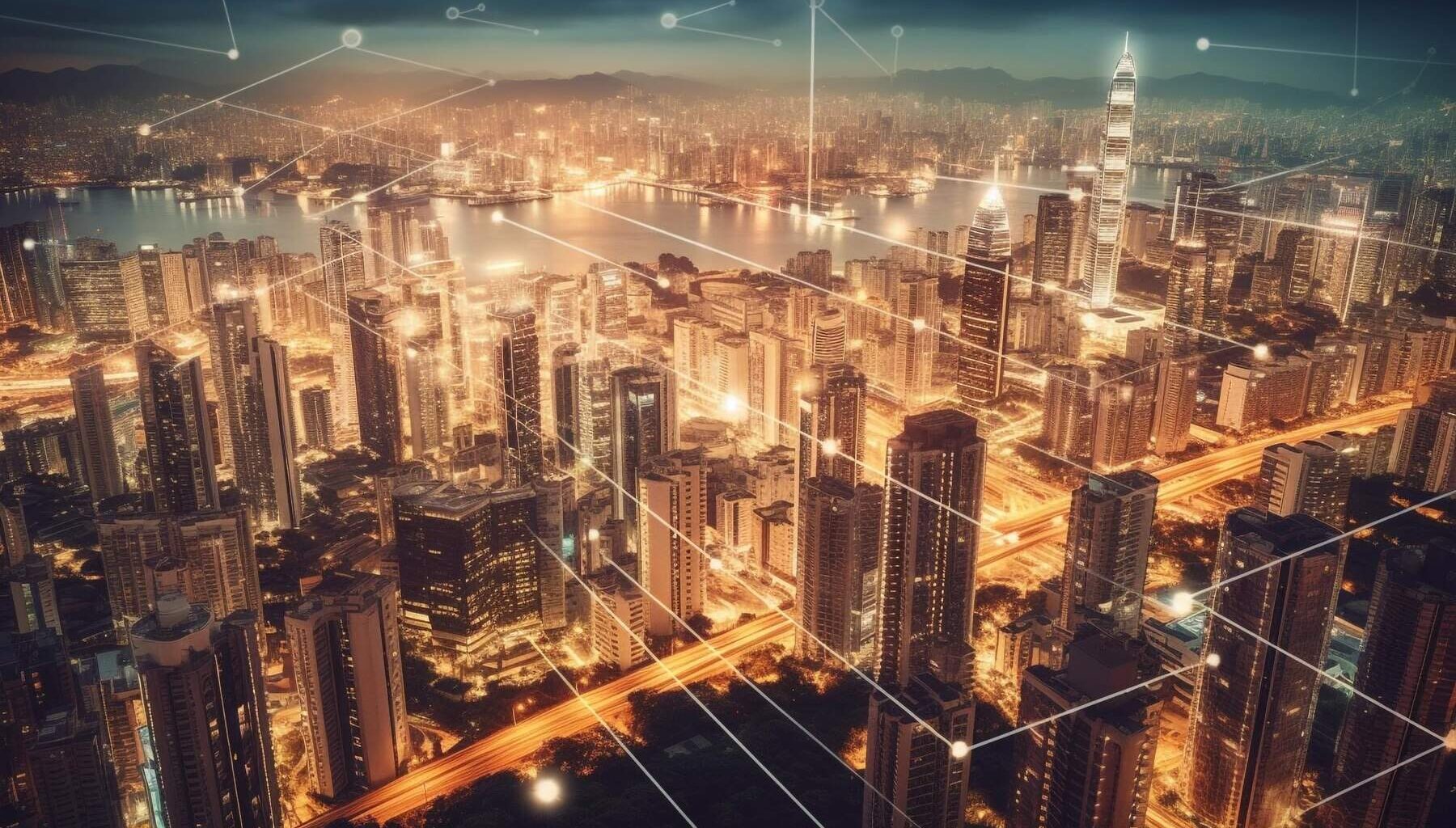Imagine a world where energy grids are self-regulating, adjusting power distribution based on real-time demand, preventing outages, and reducing energy consumption. Picture manufacturing plants where machines are monitored remotely, predicting potential failures before they occur, minimizing downtime, and maximizing production. Consider cities where traffic flow is intelligently managed, reducing congestion and improving air quality.
These scenarios are not mere fantasies; they are the realization of the transformative power of remote monitoring and control, revolutionizing industries from manufacturing and energy to healthcare and transportation. As the IoT continues to expand, the possibilities for innovation and impact are limitless.
Industry experts are rapidly recognizing the numerous advantages that the Internet of Things (IoT) offers businesses in every sector.
According to Business Insider’s forecast report, the number of IoT devices used across industries is expected to hit an impressive USD 55 billion by 2025.
Remote Rebooting & Control of Smart Interconnected Devices
Remote rebooting, enabled by IoT devices embedded within critical systems, empowers operators to remotely restart devices or components that have malfunctioned or experienced software glitches. This ability to quickly and efficiently address unexpected outages, without the need for physical intervention, minimizes downtime, prevents cascading failures, and ensures the smooth functioning of essential systems.
The integration of remote rebooting and monitoring capabilities through IoT technology is transforming various industries, from manufacturing and energy to healthcare and transportation. By providing real-time insights, enabling proactive intervention, and facilitating remote troubleshooting, IoT empowers businesses and organizations to optimize operations, minimize downtime, and safeguard against potential disruptions, ensuring the smooth functioning of their critical infrastructure and devices.
1. Demand-response management in Energy Grids
One of the most significant applications of IoT sensors in energy grids is demand-response management. By understanding real-time energy consumption patterns, utilities can identify periods of high demand and proactively implement measures to reduce consumption, such as adjusting electricity rates or offering incentives to consumers. This helps to balance supply and demand, preventing grid overloads and power outages.
For instance, in Austin, Texas, the Pecan Street Project utilizes a network of IoT sensors to monitor energy consumption in homes and businesses. This data is used to inform residents about their energy usage patterns and provide personalized recommendations for reducing consumption. As a result, participating households have reduced their energy consumption by an average of 9%.
Source: Sintef.com
2. Healthcare IoT: Medical Devices at Your Fingertips
In healthcare, where every second counts, the ability to remotely reboot medical devices can be a matter of life and death. Imagine a scenario where a critical patient monitoring device experiences a glitch. Instead of waiting for an on-site technician, healthcare providers can initiate a remote reboot, ensuring uninterrupted monitoring and timely interventions.
Smart Device Management: Key to IoT Success
In the world of smart gadgets, one thing we often forget but is super important is managing these devices. Even though it’s not a new idea, we’ve kind of ignored it lately. We usually get excited about what our gadgets can do, like turning on lights or restarting a smart speaker, but we don’t pay enough attention to how they actually work.
Sure, fixing simple things like a smart speaker or a light bulb is easy for consumers. But what happens when a crucial part, like a smart moisture sensor, stops working just after two months? That’s a real challenge.
Sadly, many cool ideas in the world of smart gadgets fail because the folks in charge don’t know how to manage these devices properly.
So, what does it mean to manage devices, especially in the ever-changing world of smart gadgets?
It boils down to three simple things:
Devices Working Well Together:
All the different parts of a device need to work together smoothly. Think of it like teamwork for gadgets to do their job well.
Keeping Device Data Separate:
It’s important to keep information about a device separate from the data it produces. This helps avoid confusion and keeps things running smoothly.
Controlling Everything from One Place:
Imagine being able to control and check the status of all your devices from one spot. It makes things easier and more efficient. Devices can broadcast a signal when they’re no longer able to communicate or function as expected, alerting technicians for fixing.
These three things are like the ABCs of making sure our smart gadgets not only do cool things but also work well behind the scenes. Understanding and following these principles will make our gadgets even smarter and more successful in the world of technology.
Sectors that Can Benefit the Most from IoT Development:
1. Healthcare:
The Internet of Medical Things (IoMT) is revolutionizing the healthcare industry by connecting medical devices, sensors, and applications to the Internet. This network of interconnected devices enables real-time data collection, analysis, and communication, transforming healthcare delivery and patient outcomes.
IoMT offers a multitude of benefits to the healthcare industry, including:
- Enhanced Patient Monitoring: Real-time data from wearable devices and implanted sensors provide continuous insights into patient health, enabling early detection of potential issues and timely interventions.
- Improved Treatment Management: IoMT-enabled devices facilitate remote monitoring of chronic conditions, allowing clinicians to track patient progress, adjust treatment plans, and optimize care.
- Remote Patient Care: Telemedicine and remote monitoring technologies enable healthcare providers to deliver care to patients in their homes or remote locations, reducing the need for in-person visits and improving accessibility.
- Preventive Care and Early Intervention: IoMT devices can identify early warning signs of potential health problems, enabling preventive care and early intervention to prevent complications and improve long-term health outcomes.
One real-life use case of IoMT’s impact in healthcare is the use of wearable devices for monitoring patients with chronic conditions such as heart disease or diabetes. These devices can continuously track vital signs, activity levels, and other health parameters, providing valuable data for clinicians to monitor patient progress and adjust treatment plans accordingly.
A study published in the Journal of the American Medical Association found that the use of wearable devices for remote monitoring of patients with heart failure resulted in a 20% reduction in hospital readmission rates.
IoMT is poised to continue transforming healthcare, enabling more personalized, proactive, and effective care delivery. As sensor technology advances, data analytics become more sophisticated, and connectivity expands, the possibilities for IoMT-driven innovation in healthcare are limitless.
2. Finance:
The Internet of Things (IoT) is gaining ground in ensuring robust security for financial transactions. Banks and customers have seamlessly integrated various connected devices into managing financial operations, including smart cash points with connected vending machines. Financial institutions are looking to new IoT technologies to lower costs and improve user experience. For example, some banks have begun to use beacons to provide personalized offers directly to consumers’ smartphones as soon as they walk into the branch. Additionally, certain ATMs now provide live stream video support, enabling users to communicate with bankers in case they need extra help.
Source: VMR
The vast amount of data handled by IoT enables financial institutions to measure and manage risks and seize opportunities accurately. Looking ahead, banks are poised to leverage sensors and data analytics for more in-depth customer insights, offering personalized services that align with individual spending behaviors.
IoT adoption in banking promises additional benefits:
- Cultivation of Financial Habits through Connected Devices
- Enhanced Banking Experience
- Interactive Credit Cards
- Streamlined Automated Processes for Banks
3. Agriculture:
The Agriculture industry, traditionally open to innovation, is now tech-driven and industrialized thanks to the Internet of Things (IoT). According to Statista, the global IoT market size for Agriculture was $14.79 billion in 2018 and is projected to hit nearly $30 billion by 2030.
Smart Agriculture, the IoT’s application in farming, utilizes sensors to gather environmental and machine metrics. This data empowers farmers to enhance decision-making across various aspects, from livestock to crop farming.
Key IoT Use Cases in Agriculture:
Agricultural Drones:
Equipped with sensors and cameras, drones assist in imaging, mapping, and surveying farms. They handle tasks like planting crops, pest control, spraying, and crop monitoring, reducing the need for manual labor.
Greenhouse Automation:
IoT sensors provide real-time information on greenhouse conditions, including lighting, temperature, soil, and humidity, optimizing manual intervention.
Climate Monitoring:
Weather stations and smart farming sensors collect data for cloud analysis, enabling informed decisions on crop selection based on climate conditions.
Cattle Monitoring:
IoT sensors track and monitor livestock, ensuring efficient management and well-being.
Risk Control and Production Optimization:
IoT empowers farmers with insights into production output, enabling precise planning to avoid surplus and mitigate risks.
4. Energy:
IoT technology is transforming the energy sector by introducing innovative solutions that enhance efficiency, sustainability, and overall operational capabilities. With advancements in IoT edge development, devices, and sensors are seamlessly integrated into energy infrastructure, offering real-time insights and control.
According to global statistics, In 2020, the global value of IoT in the Energy market reached $20.2 billion, projected to surge to $35.2 billion by 2025.
How IoT is Revolutionizing The Energy Sector?
The energy sector is undergoing a remarkable transformation driven by the integration of Internet of Things (IoT) technology. At the heart of this transformation lies the concept of smart grids, a network of interconnected devices and sensors that enables real-time monitoring, analysis, and control of energy distribution. Sensors placed on equipment detect issues in real-time, allowing for proactive maintenance and minimizing downtime. This not only improves the reliability of energy distribution but also contributes to cost savings.
Furthermore, IoT plays a crucial role in optimizing energy consumption. Smart meters and sensors in buildings collect data on energy usage, enabling businesses and consumers to make informed decisions about energy efficiency. This leads to reduced energy wastage and lower costs, aligning with sustainability goals.
In the context of renewable energy, IoT technology enhances the performance of solar panels and wind turbines. Sensors gather data on environmental conditions, allowing for better prediction of energy generation. This predictive capability ensures optimal utilization of renewable resources, making the energy production process more reliable and sustainable.
A recent study by the AEEI found that IoT-enabled smart grid technologies can increase the integration of renewable energy sources into the grid by up to 30%, reducing reliance on fossil fuels and lowering carbon emissions.
Conclusion:
As we navigate the ever-evolving landscape of remote monitoring and control in IoT, it’s essential to align with experts who not only understand the nuances of this technology but also have a proven track record in delivering robust IoT solutions. Codewave.com stands out as a beacon in this space, offering comprehensive IoT development services that leverage innovative approaches to remote rebooting.
With a wealth of experience spanning two decades, we bring unparalleled expertise to the table. Our commitment to pushing the boundaries of what’s possible in IoT solutions is evident in our track record of successful implementations across global companies. If you’re seeking a partner to navigate the complexities of IoT and harness the full potential of remote rebooting, we are ready to collaborate.
In the dynamic landscape of IoT, the ability to remotely reboot devices isn’t just a feature—it’s a strategic advantage. Embrace the future of IoT with Codewave.com, where innovation meets reliability.
Get in touch with our IoT experts today. Your journey to a resilient and efficient IoT ecosystem begins here.
Codewave is a design thinking led digital transformation company enabling organisations with playful innovation using AI & ML, IoT & Edge, AR, VR, Cloud, Blockchain, and Data.







